Beauty brands are talking a lot more about sustainability and the environment, and it makes sense. Climate change is a huge problem, and most of us don’t want to make things worse.
But beauty marketing is full of false promises and meaningless buzzwords. What’s actually better for the environment, and what’s just feelgood fluff?
Well… a lot of it is fluff.
In this two-part series, Jen of The Eco Well and I be breaking down some of the most common myths that brands use to pretend they’re greener than they are, so you can see through the greenwashing more easily and make informed decisions about what to buy.
This part is about natural ingredients and their impacts, part 2 is about petrochemicals and plastic, as well as what we can do to actually be more sustainable.
The video is here, keep scrolling for the text version…
Myth: Natural ingredients don’t harm the environment
Let’s start with the idea that natural ingredients are better for the environment than synthetic ones, when you finish using them and they drift off into the environment.
“Reef-safe” zinc sunscreens
This myth shows up a lot with sunscreens (I can’t get away from talking about sunscreens), so let’s look at that as an example.
Some places are banning “unnatural” chemical sunscreens, because of the idea that they harm coral reefs. But this isn’t based on good evidence – I’ve talked about this before.
Related post: Is Your Sunscreen Killing Coral Reefs? The Science
Instead, these places are promoting “reef-safe” mineral sunscreens, mostly with zinc oxide, based on this assumption that it’s natural, and therefore won’t harm coral or any other wildlife.
That is not true.
When zinc oxide sunscreen gets washed off your body, it doesn’t necessarily end up someplace that naturally has zinc oxide. And even if it does, it can raise the concentration there compared to before. Since how harmful something is depends on how much there is (“the dose makes the poison”), extra zinc oxide can be a problem.
Related post: Clean Beauty Is Wrong and Won’t Give Us Safer Products
There are actually a lot of studies showing that zinc oxide is toxic to coral and other aquatic organisms.
For example, these data tables come from a 2022 National Academies report on the environmental impacts of sunscreen. Each of these rows is an example of a harmful effect on wildlife that zinc oxide has been found to have.

The report also has this diagram that compares the toxicity of different chemical (“synthetic”) and physical (“natural”) sunscreen ingredients:
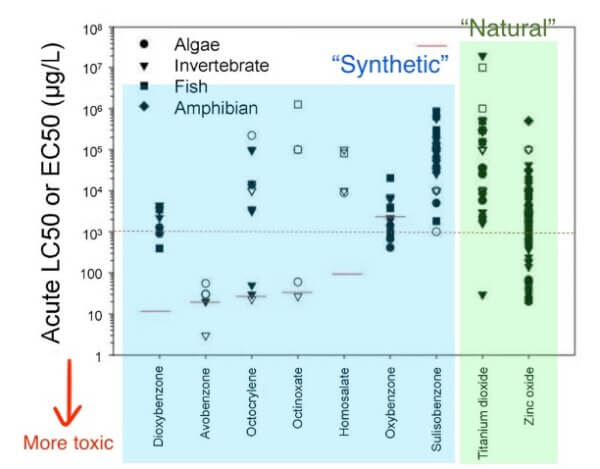
Each black dot is the amount that caused a toxic effect in a study. The lower a dot is on this graph, the less you need of that ingredient to have the harmful effect – in other words, the more potently harmful it is.
You can see that both zinc oxide and titanium dioxide (the other “natural” sunscreen ingredient) can start causing harm at lower concentrations than some “unnatural” chemical sunscreens.
As the report says:
“organic [chemical] and inorganic [physical] UV filters completely overlap with respect to acute toxicity.”
(This is the case for chronic toxicity as well.)
Non-nano zinc?
And this is still the case with non-nano zinc oxide. “Nano” refers to smaller particles (1 to 100 nanometres in diameter) that tend to be used in sunscreens because they protect against UV better, and look less… clown-like.

In a lot of sunscreen marketing, you’ll see this idea that if you use larger non-nano particles, it’s completely safe.

But zinc oxide dissolves in water, which means larger particles will get smaller (mindblowing, I know!).
Plus the dissolved zinc ions can also be harmful. Zinc is a micronutrient that living organisms need, but it’s also a heavy metal – it’s toxic if there’s too much.
That’s why if you look up the Safety Data Sheet for zinc oxide, you’ll see a symbol featuring a dead fish, surrounded by warnings about how it’s “very toxic to aquatic life”. Zinc oxide (even when not in nano form) has been recognised as potentially toxic for a long time.
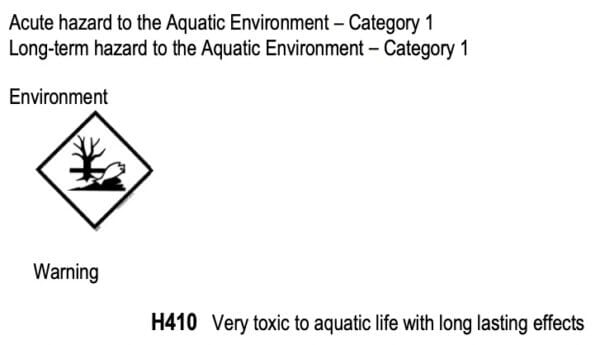
Neither chemical nor mineral sunscreens seem to be a big issue for coral reefs – based on the relevant evidence so far, the amounts near reefs are too low to be having that much of an impact, especially in light of other stressors like rising temperatures. Research is still ongoing for other aquatic organisms.
But it’s clear that zinc oxide is not a completely safe alternative.
And this goes for pretty much any natural ingredient – just because it’s natural doesn’t mean it’s safe.
Which you hopefully already know, because nature is always trying to kill us.
Related Post: Natural vs. Chemical – Which Is Better?
“Natural” is not always natural
Also, the zinc oxide and titanium dioxide in sunscreens isn’t really natural most of the time, it’s usually manmade – because if you just take them from nature, they’re often contaminated with very natural toxic heavy metals like lead.
This is also the reason why natural iron oxides, which are the skin coloured pigments in foundation, aren’t allowed in cosmetics in the US – they have to be synthetic.
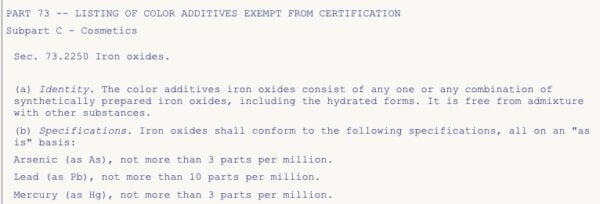
Myth: Natural ingredients are more environmentally friendly to produce than synthetic ones
When we talk about the environmental impacts of different ingredients in our products, we usually focus on where the ingredients go after we use them.
This is a recurring theme. What we can see and control is usually what we think about: where the product goes after we’ve used it (we can see it going down the drain), and what we do with the empty packaging.
But this is only one part of environmental impact. There’s also getting the ingredients in the first place, and a lot of people assume that natural ingredients are more environmentally friendly to produce than synthetic ones.
Again, this is not true. And this production part is a really big factor when it comes to overall environmental impact.
Product life cycle
The more holistic way of thinking about impact is to look at the whole life cycle of the product:
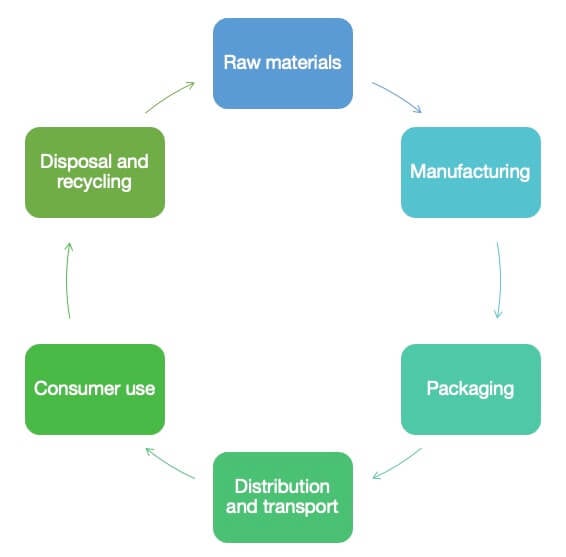
Most of the time we focus on just the disposal and recycling part (also called end-of-life). But there’s a lot that happens before the product actually gets to you, and all of these have environmental impacts.
The raw materials get processed and turned into ingredients, which get turned into your product (manufacturing). The same steps happen to make the packaging.
Your product then gets shipped a bunch of times (there’s also a bunch of shipping in the first part), then it ends up at your house, you use it (which is another big part of impact, for example water use)… and then there’s disposal and recycling.
We’ve already talked about the disposal of ingredients, and how natural isn’t always better. But natural isn’t automatically better when it comes to production either.
Sourcing ingredients from nature
When we hear “natural”, it kind of sounds like someone wanders through a forest and picks leaves off trees and mashes them to make your products while birds chirp and deer dance.
It just sounds more sustainable.
But that’s pretty far from reality. There are lots of natural ingredients that have huge environmental costs to produce.
Take essential oils, for example. It can take hundreds to thousands of kilograms of plant material to get a single kilogram of essential oil, and many essential oils are mostly sourced from plants growing in the wild… or at least the wild versions are more valuable.
One example that Jen’s talked about before is Indian sandalwood.
Jen: Sandalwood is the most economically important tree globally.
The value hinges on aromatic chemical composition, namely high santalol content. Santalol content is concentrated as trees get older. Harvesting generally happens when the trees are no younger than 30 years old.
This coupled with growing demand plus widespread fungal infection that has impacted most of the sandalwood trees in India has driven the species to endangerment.
Adulteration, smuggling and illicit trade remain major challenges.
Another example is licorice extract. In skincare, it’s usually wild harvested licorice that’s used, because it has a higher concentration of the active components.
Jen: Wild licorice has been uncontrollably over harvested to the point that there is now more licorice being sold in the market than there is being produced.
Licorice helps soils with sand management and therefore, over exploitation of wild licorice in the sandy regions it typically grows, directly contributes to desertification.
Cultivating natural ingredients
For both sandalwood and licorice, the obvious solution is to limit wild harvesting (which is harder than it sounds), and switch to farmed versions, which is a bit less “natural”, and usually lower quality.
There’s been efforts to increase the quality of farmed versions, but that’s also harder than it sounds.
And even though in these cases, farming is more sustainable than wild harvesting, it’s still not great for the environment.
Jen: Agriculture has a huge impact on the environment. According to the 2019 IPBES report, agricultural expansion into intact ecosystems was the greatest threat to biodiversity loss.
Agriculture is also a significant contributor to greenhouse gas emissions.
And we don’t just farm cosmetic ingredients. The land and resources could’ve been used to produce food instead.
Jenn: Food security is a really big issue. Right now, we have an immense global challenge of figuring out how to feed our growing population with the limited resources we have, while also reducing our impacts.
From my perspective, it’s hugely problematic to divert agri-space away from food towards production of things like cosmetics or aroma chemicals, especially if there’s a less impactful way of production already available.
And these less impactful ways of production can be natural or synthetic.
Jen: Ultimately, it’s complex and it depends.
Many natural materials in cosmetics are byproducts of food, agriculture, or even biodiesel production, albeit this in itself is problematic for similar reasons.
Some essential oils are produced via byproducts and could be considered “upcycled”.
For these, the continued use of natural materials make sense.
And a lot of the time, ingredients made from byproducts are also cheaper.
This links to another really annoying marketing trope: a lot of clean, natural brands like to brag about how precious and rare their ingredients are, how many rose petals are in each bottle, how long it took to grow, and they shame other ingredients (usually synthetic ones) as being “cheap”. And then at the same time, they claim to be more sustainable.
Related Post: Parabens, Fragrance, Colorants, Talc: Debunking Bobby Parrish’s TikTok misinformation
This makes zero sense. If more resources went into making a product, that’s not sustainable. “Cheap” products that are made from salvaged waste materials are usually a more sustainable option, even though there’s this sort of snobbery against them. Turning waste into something useful and valuable is a good thing from an environmental perspective.
And on this theme of making the most out of limited resources, here’s the next myth:
Myth: Organically farmed ingredients are more environmentally friendly than conventionally farmed ones
Most people think “organic” means more environmentally friendly, because that is what organic farming organisations say their goal is – it’s in all 4 of their fundamental principles.

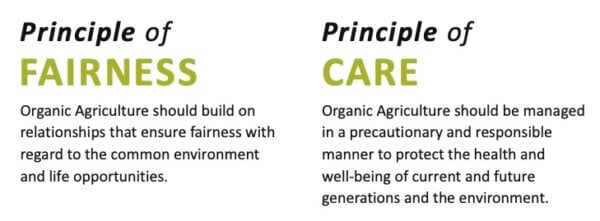
But if you look at the actual rules farmers need to follow to be “certified organic”, you’ll see that they aren’t actually based on scientific evidence. It’s mostly just based on “naturalness”.
“In general, synthetic substances [like pesticides and fertilisers] are prohibited … and non-synthetic substances are allowed” – USDA Organic

But like we’ve discussed, natural isn’t necessarily better for the environment, and this applies to pesticides too.
More and more studies have found that organic farming can actually end up with greater environmental impacts in a lot of areas.
This 2017 meta-analysis compared a bunch of studies that looked at the environmental impacts of producing 90 different foods using conventional versus organic farming.
The higher the dot is on this graph, the worse organic farming is compared to conventional farming.
First off you can see that a lot of it depends on the type of food (the different coloured dots representing various categories of food are at different heights).
There’s also a lot of variation for the specific farms, in different countries (for a lot of the data sets, there’s a really long line, indicating the huge range involved).
So it isn’t like conventional or organic is always better for the environment.
But there are some categories of environmental impact where organic is generally worse, like land use, eutrophication and acidification.
And since 2017, there’s been more analyses where scientists have started to take land use into account when looking at greenhouse gas emissions, which this analysis didn’t do.
Organic farming tends to be less efficient – more land is needed to produce the same amount of a crop. And if you’re using that land for farming, you generally need to clear trees.
Less trees means less carbon dioxide absorbed. So there’s essentially an opportunity cost.

And if you factor the greater land use in, it turns out that organic farming usually produces a lot more greenhouse gases.
One analysis found that in Sweden, organic peas would have a 50% greater greenhouse gas impact than conventionally farmed peas. For winter wheat, the difference was 70%.
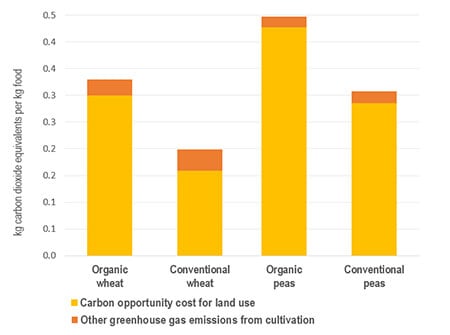
Jen: In order to meet our growing demand, in light of the environmental limitations and impacts associated with agriculture, we need to figure out how to produce more ingredients with the same or even less impact.
Despite that, there’s a market push to tell us that organic is sustainable. There are some serious limitations of organic agriculture, especially pertaining to its efficiency.
This isn’t to say that organic agriculture is unsustainable, full stop. In some regions it may make sense, in the same way that in other regions, conventional agriculture or even genetic engineering may be the better option.
Ultimately, there are no panaceas when it comes to sustainability in agriculture.
Whether organic or conventional methods are better changes a lot depending on the context and what impact you’re looking at – not even just with specific crops and environmental impacts, but also things like pesticide exposure for farmers and consumer prices.
Even if we look at biodiversity, which is one of the most widely accepted advantages of organic farming, it turns out that if you take the extra land use into account, on average it breaks even.
The obvious solution would be to use whatever methods have lower environmental impacts in a particular situation, whether they’re organic or not… but organic doesn’t allow that. It just limits the options farmers have, based on the misconception that “natural is better”.
In some situations, like for cereal crops and bird biodiversity, it’s better to produce the same amount of food in a smaller area using conventional farming, and leave a strip of unfarmed land than to use the whole area for organic farming.
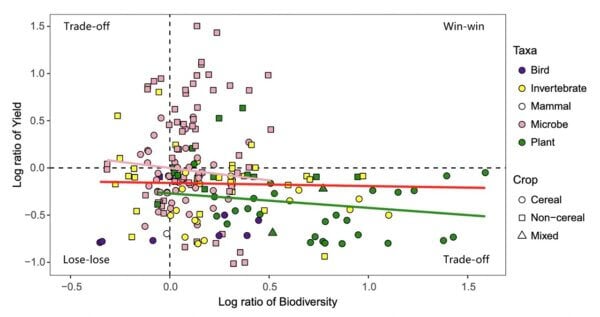
But that wouldn’t be allowed under organic rules. And there are more examples now of more environmentally sustainable farming practices that kind of just ignore organic.
Stability and product waste
And we haven’t even dealt with the mould thing yet. Natural products tend to have shorter shelf lives and go off faster than products with more synthetic components. A lot of synthetic substances were originally designed as improvements on naturally occurring chemicals.
It’s not always the case, but there’s a reason why no one is that surprised when natural products have texture or colour changes, or grow mould. And if you have to throw out half the product, that means the stuff you used was actually about twice as resource intensive to produce.
That’s it for Part 1! Click here to keep reading Part 2: Petrochemicals and plastic packaging.

References
National Research Council. Review of Fate, Exposure, and Effects of Sunscreens in Aquatic Environments and Implications for Sunscreen Usage and Human Health. The National Academies Press; 2022. DOI: 10.17226/26381.
Dyer SD, Green NS. Use of Eco-epidemiology to Assess the Potential Risks of UV Filters to Corals. Presentation at: National Academies Sunscreen Study; September, 2021.
US Food and Drug Administration. CFR—Code of Federal Regulations, Title 21, Volume 1 (21CFR73.2250). Accessed May 14, 2023.
Herbes C, Beuthner C, Ramme I. Consumer attitudes towards biobased packaging – A cross-cultural comparative study. J Clean Prod. 2018;194:203-218. DOI: 10.1016/j.jclepro.2018.05.106.
Essential Oil Yields. Aroma Web. Published 2017. Accessed May 14, 2023.
Sudhakar U. This Indian tree prized by Chinese royalty is on the road to extinction. The Times of India. Published January 18, 2022. Accessed June 2, 2023.
Gemedzhieva N, Khrokov A, Heral E, Timoshyna A. Sweet dreams: Assessing opportunities and threats in Kazakhstan’s wild liquorice root trade. TRAFFIC; 2021.
Yang F, Chu T, Zhang Y, Liu X, Sun G, Chen Z. Quality assessment of licorice (Glycyrrhiza glabra L.) from different sources by multiple fingerprint profiles combined with quantitative analysis, antioxidant activity and chemometric methods. Food Chem. 2020;324:126854. DOI: 10.1016/j.foodchem.2020.126854
Tripathi S, Kumar P, Rout PK, Share SK, Naik S. Comparison of yield and quality of sandalwood oil extracted from heartwood of trees cultivated in different states of India. Mater. Today: Proc 2022;57(6):2400-2405. DOI: 10.1016/j.matpr.2021.12.536
Intergovernmental Science-Policy Platform on Biodiversity and Ecosystem Services. Global assessment report on biodiversity and ecosystem services of the Intergovernmental Science-Policy Platform on Biodiversity and Ecosystem Services. IPBES secretariat; 2019. DOI: 10.5281/zenodo.3831673
Intergovernmental Panel on Climate Change. Climate Change and Land: an IPCC special report on climate change, desertification, land degradation, sustainable land management, food security, and greenhouse gas fluxes in terrestrial ecosystems. 2019.
Teigiserova DA, Tiruta-Barna L, Ahmadi A, Hamelin L, Thomsen M. A step closer to circular bioeconomy for citrus peel waste: A review of yields and technologies for sustainable management of essential oils. J Environ Manage. 2021;280:111832. DOI: 10.1016/j.jenvman.2020.111832
Dell’Acqua G. Garbage to glamour: recycling food by-products for skin care. Cosmetics & Toiletries. Published February 6, 2017. Accessed May 2, 2023.
Principles of Organic Agriculture. IFOAM Organics International; 2020.
Coleman P. Guide for Organic Crop Producers. USDA Organic; 2012.
Australian Certified Organic Standard 2021 Version 1. Australian Organic Limited; 2021.
Bahlai CA, Xue Y, McCreary CM, Schaafsma AW, Hallett RH. Choosing organic pesticides over synthetic pesticides may not effectively mitigate environmental risk in soybeans. PLoS One 2010;5(6):e11250. DOI: 10.1371/journal.pone.0011250
Clark M, Tilman D. Comparative analysis of environmental impacts of agricultural production systems, agricultural input efficiency, and food choice. Environ Res Lett. 2017;12(6):064016. DOI: 10.1088/1748-9326/aa6cd5.
Ritchie H. Is organic really better for the environment than conventional agriculture? Our World in Data. Published 2017. Accessed May 2, 2023.
Searchinger TD, Wirsenius S, Beringer T. et al. Assessing the efficiency of changes in land use for mitigating climate change. Nature 2018;564:249–253. DOI: 10.1038/s41586-018-0757-z
Gong S, Hodgson JA, Tscharntke T, et al. Biodiversity and yield trade-offs for organic farming. Ecol Lett. 2022;25(7):1699-1710. DOI: 10.1111/ele.14017
Seufert V, Ramankutty N. Many shades of gray – The context-dependent performance of organic agriculture. Sci Adv. 2017;3(3):e1602638. DOI: 10.1126/sciadv.1602638
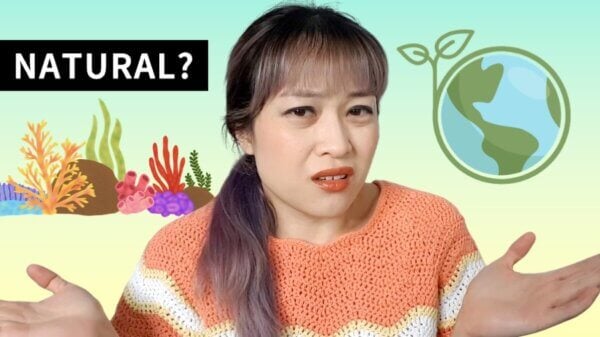
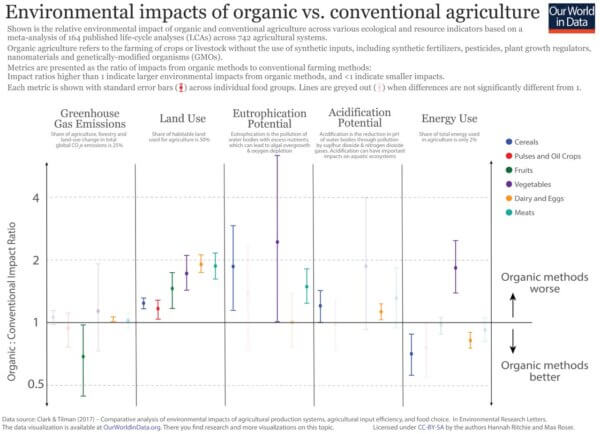


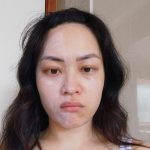

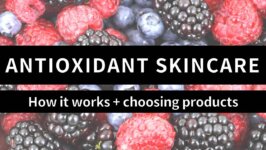
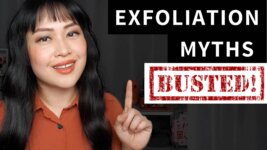
Dont forget organic faring actually uses pesticides.
The so called “natural” pesticides :
– copper which accululate insoils leading to sterilisation
– pyrethrins which extraction has lead to dispatition of protected rain forests necessary to the little montain gorilla (now in danger)
– neem extract (ai = azadirachtin) which has strong evidence of being a strong endocrine disruptor
Not to mention the lack of fungicide control close to the harvest with the deadly risk of aflatoxine exposure